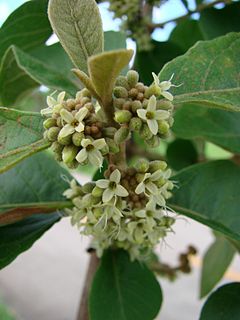Bonnetia fasciculata is a species of flowering plant in the Bonnetiaceae family. It is found only in Venezuela.

The long-tailed porcupine is a species of rodent in the family Hystricidae. It is monotypic within the genus Trichys, and is found in Brunei, Indonesia, and Malaysia.
Aegiphila cordifolia is a species of flowering plant in the family Lamiaceae. It is endemic to Peru, where it occurs in the Amazon rainforest. It is sometimes found in disturbed habitat.

Aegiphila is a genus of flowering plants in the mint family, Lamiaceae, first described in 1763. It was formerly classified in the Verbenaceae. It is native to Mexico, Central America, South America, the West Indies, and Florida.

Aegiphila ferruginea is a species of flowering plant in the family Lamiaceae. It is endemic to Ecuador. It occurs in the high Andes between 2000 and 4000 meters in elevation, where it grows in cloud forest. There are about 15 wild populations known. It is a shrub or tree that grows easily in disturbed habitat and it can be a common roadside plant in some areas. It is also cultivated on a small scale.
Aegiphila glomerata is a species of flowering plant in the family Lamiaceae. It is endemic to Ecuador, where it has been found at only three locations. It occurs in low-elevation coastal dry forests.
Aegiphila monticola is a species of tree in the family Lamiaceae. It is endemic to Ecuador, where it is known from Cotopaxi and Bolívar Provinces. There are about eight populations.
Aegiphila purpurascens is a species of tree in the family Lamiaceae. It is endemic to Azuay Province in Ecuador, where only three populations are known. It grows in the cloud forests of the Andes at 2000 to 3000 meters in elevation.
Aegiphila rimbachii is a species of tree in the family Lamiaceae. It is endemic to Bolívar Province in Ecuador, where it grows in the cloud forests of the Andes.
Aegiphila schimpffii is a species of tree in the family Lamiaceae. It is endemic to Ecuador, where it is known from five populations. It occurs in coastal forest habitat and foothills up to 1000 meters in elevation.
Aegiphila skutchii is a species of flowering plant in the family Lamiaceae. It is native to Guatemala, Honduras, and Mexico.
Aegiphila sordida is a species of flowering plant in the family Lamiaceae. It is endemic to Peru.

Aureliana fasciculata is a species of plant in the family Solanaceae. It is endemic to Brazil. It is threatened by habitat loss.
Myristica fasciculata is a species of plant in the family Myristicaceae. It is endemic to Papua New Guinea.
Myrsine fasciculata is a species of plant in the family Primulaceae endemic to French Polynesia.
Ryparosa fasciculata is a species of plant in the family Achariaceae. It is a tree endemic to Peninsular Malaysia. It is threatened by habitat loss.
Dendrocousinsia fasciculata is a species of plant in the family Euphorbiaceae. It is endemic to western and central Jamaica.
Trichilia fasciculata is a species of plant in the family Meliaceae. It is endemic to Brazil. It is threatened by habitat loss.
Aegiphila caymanensis is a species of mint endemic to Grand Cayman. It is a scrambling shrub with one rooting point, it is inconspicuous when not in flower. This species is probably extinct; the last known specimen was bulldozed in August 2015.
Aegiphila monstrosa is a species of flowering plant in the family Lamiaceae. It is found in Belize, Guatemala, Honduras, and Mexico. It is threatened by loss of habitat to agriculture.




